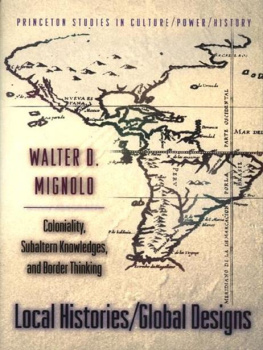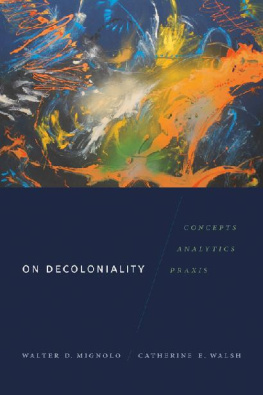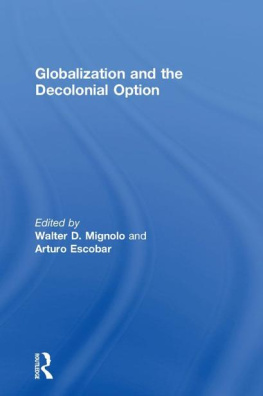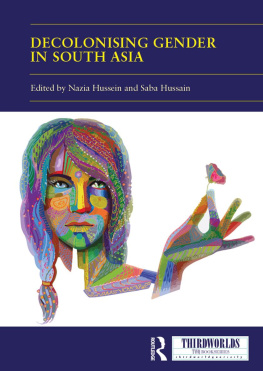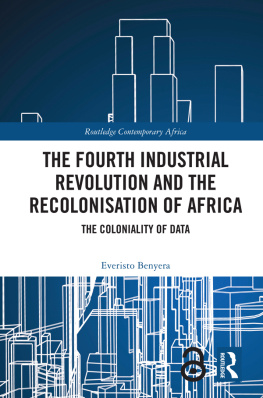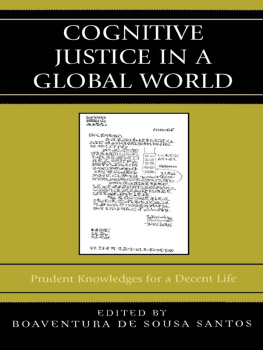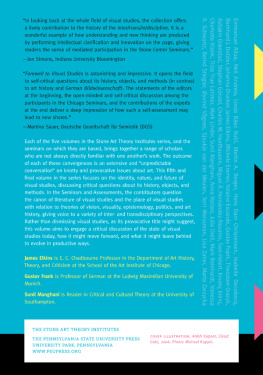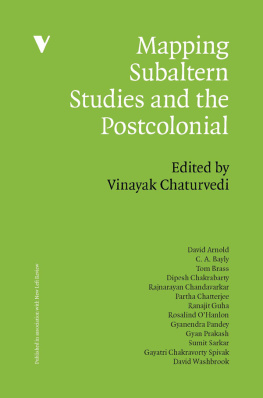EDITORS
Sherry B. Ortner, Nicholas B. Dirks, Geoff Eley
A LIST OF TITLES
IN THIS SERIES APPEARS
AT THE BACK OF
THE BOOK
LOCAL HISTORIES/GLOBAL DESIGNS
COLONIALITY, SUBALTERN KNOWLEDGES,
AND BORDER THINKING
Walter D. Mignolo
Copyright 2000 by Princeton University Press
Published by Princeton University Press, 41 William Street,
Princeton, New Jersey 08540
In the United Kingdom: Princeton University Press,
Chichester, West Sussex
All Rights Reserved.
Library of Congress Cataloging-in-Publication Data
Mignolo, Walter.
Local histories/global designs : coloniality, subaltern
knowledges, and border thinking / Walter D. Mignolo.
p. cm. (Princeton studies in culture/power/history)
Includes bibliographical references and index.
ISBN 0-691-00139-1 (alk. paper). ISBN 0-691-00140-5 (pb : alk. paper)
1. Colonies. 2. Postcolonialism. 3. Culture. 4. Knowledge.
Theory ofPolitical aspects. 5. Hermeneutics. I. Title. II. Series.
JV51.M54 1999
901dc21 99-32342
This book has been composed in Berkeley Ten
The paper used in this publication meets the minimum requirements
of ANSI/NISO Z39.48-1992 (R1997) (Permanence of Paper)
http://pup.princeton.edu
1 3 5 7 9 10 8 6 4 2
Printed in the United States of America
______________ To Andrea and Alexander ______________
FOR ALL THE CONVERSATIONS BETWEEN
HIGH SCHOOL AND COLLEGE, MANY OF THEM RELATED TO THE TOPIC
OF THIS BOOK WHEN IT WAS STILL IN PROGRESS
To Anne
FOR MAKING THOSE CONVERSATIONS POSSIBLE, AND FOR HER
PATIENCE AND UNDERSTANDING
_________________ Contents _________________
Introduction
On Gnosis and the Imaginary of the Modern/Colonial World System
Chapter 1
Border Thinking and the Colonial Difference
Chapter 2
Post-Occidental Reason: The Crisis of Occidentalism and the Emergenc(y)e of Border Thinking
Chapter 3
Human Understanding and Local Interests: Occidentalism and the (Latin) American Argument
Chapter 4
Are Subaltern Studies Postmodern or Postcolonial? The Politics and Sensibilities of Geohistorical Locations
Chapter 5
An Other Tongue: Linguistics Maps, Literary Geographies, Cultural Landscapes
Chapter 6
Bilanguaging Love: Thinking in between Languages
Chapter 7
Globalization/Mundializacin: Civilizing Processes and the Relocation of Languages and Knowledges
Afterword
An Other Tongue, An Other Thinking, An Other Logic
__________ Preface and Acknowledgments _________
THE MAIN, topic of this book is the colonial difference in the formation and transformation of the modern/colonial world system. Immanuel Wallerstein's (1974, 1980, 1989) seminal and controversial study is my starting point and the colonial difference my departing point. A corollary and consequence of it constitute the second topic, the emergence of the Americas and their historical location and transformation in the modern/colonial world order, from 1500 to the end of the twentieth century. The modern world system was described and theorized from inside itself, and the variety of colonial experiences and histories were attached to it and look at if from inside the system. However, it has an advantage over the chronology of the early modern, modern, and late modern periods I adopted in The Darker Side of the Renaissance (Mignolo 1995a, 2). And the advantage is the spatial dimension imbedded in the modern world system that is lacking in the linear conception of modern Western history. The spatial dimension of the system shows its external borders where the colonial difference was and still is played out. Until the middle of the twentieth century the colonial difference honored the classical distinction between centers and peripheries. In the second half of the twentieth century the emergence of global colonialism, managed by transnational corporations, erased the distinction that was valid for early forms of colonialism and the coloniality of power. Yesterday the colonial difference was out there, away from the center. Today it is all over, in the peripheries of the center and in the centers of the periphery.
The colonial difference is the space where coloniality of power is enacted. It is also the space where the restitution of subaltern knowledge is taking place and where border thinking is emerging. The colonial difference is the space where local histories inventing and implementing global designs meet local histories, the space in which global designs have to be adapted, adopted, rejected, integrated, or ignored. The colonial difference is, finally, the physical as well as imaginary location where the coloniality of power is at work in the confrontation of two kinds of local histories displayed in different spaces and times across the planet. If Western cosmology is the historically unavoidable reference point, the multiple confrontations of two kinds of local histories defy dichotomies. Christian and Native American cosmologies, Christian and Amerindian cosmologies, Christian and Islamic cosmologies, and Christian and Confucian cosmologies among others only enact dichotomies when you look at them one at a time, not when you compare them in the geohistorical confines of the modern/colonial world system. The colonial difference in/of the modern/colonial world is also the place where Occidentalism, as the overarching imaginary of the modern/colonial world, was articulated. Orientalism later and area studies more recently are complementary aspects of such overarching imaginary. The end of the cold war and, consequently, the demise of area studies correspond to the moment in which a new form of colonialism, a global colonialism, keeps on reproducing the colonial difference on a world scale, although without being located in one particular nation-state. Global colonialism reveals the colonial difference on a world scale when Occidentalism meets the East that was precisely its very condition of possibilityin the same way that, paradoxically, Occidentalism in the eighteenth and nineteenth centuries was the condition of possibility of Orientalism.
Border thinking (or border gnosis as I explain soon) is a logical consequence of the colonial difference. It could be traced back to the initial moment of Spanish colonialism in the Andes and Mesoamerica. In the Andes, the by now classic critical narrative in images by Amerindian Guaman Poma (Waman Puma), Nueva cornica y buen gobierno, at the end of the sixteenth and the beginning of the seventeenth century (Murra and Adorno 1980), is an outstanding exemplar. As I already analyzed in The Darker Side of the Renaissance (1995a, 24756; 30311), the fractured locus of enunciation from a subaltern perspective defines border thinking as a response to the colonial difference. Nepantla, a word coined by Nahuatl speaker in the second half of the sixteenth century, is another exemplar. To be or feel in between, as the word could be translated into English, was possible in the mouth of an Amerindian, not of a Spaniard (see Mignolo 1995b). The colonial difference creates the conditions for dialogic situations in which a fractured enunciation is enacted from the subaltern perspective as a response to the hegemonic discourse and perspective. Thus, border thinking is more than a hybrid enunciation. It is a fractured enunciation in dialogic situations with the territorial and hegemonic cosmology (e.g., ideology, perspective). In the sixteenth century, border thinking remained under the control of hegemonic colonial discourses. That is why Waman Puma's narrative remained unpublished until 1936 whereas hegemonic colonial discourses (even when such discourses were critical of the Spanish hegemony, like Bartolome de las Casas) were published, translated, and highly distributed, taking advantage of the emerging printing press. At the end of the twentieth century, border thinking can no longer be controlled and it offers new critical horizons to the limitations of critical discourses within hegemonic cosmologies (such as Marxism, deconstruction, world system analysis, or postmodern theories).
Next page
